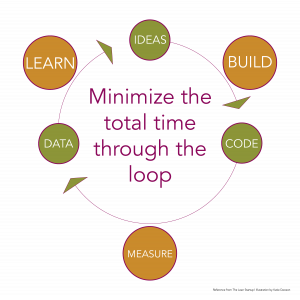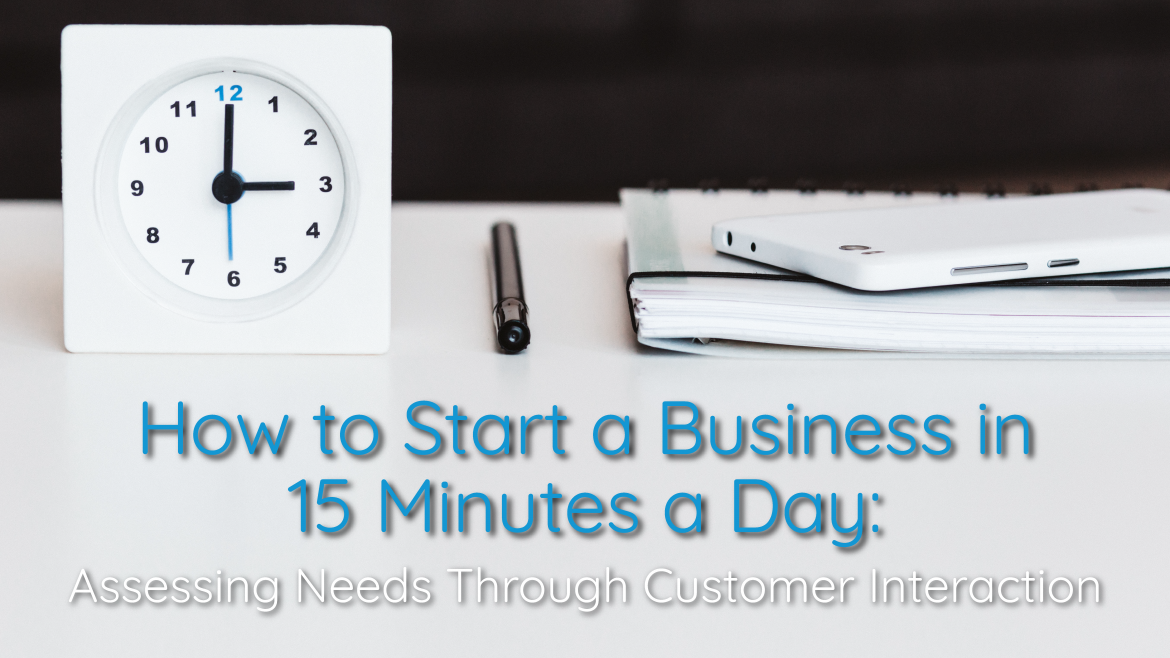Part 2 – Assessing Needs Through Customer Interaction
Continuing with your entrepreneurial endeavor takes commitment, focus, and passion. Now that you’ve completed the first pieces of this guide and worksheet, it is important to shift your mentality towards being in the shoes of your customer or user. This mindset shift is important and should remain, at least periodically, throughout your entire journey.
This series aims to provide a formal plan and steps to support new entrepreneurs seeking a process of launching a new business by breaking down the major components and first steps over a multi-part, day to day guide. Each part will highlight a major theme and provide daily, 15-minute activities for the upcoming month to help get you moving towards launching your new business!
Congratulations! You have now selected a business idea that you are serious about…right? After completing the steps in ideation, I suspect you feel both confident and overwhelmed. Good! Never forget an important distinction between a startup and a business…a startup is an organization created to search for a business model that is repeatable and scalable. This definition gives you the freedom and flexibility to keep working on your idea without unrealistic expectations. Let’s say your goal really is to search for a business model in order to determine whether you really have a business…then where do you start? Let’s jump in.
Using the Business Model Canvas
The Business Model Canvas (BMC) is a tool for searching for a repeatable scalable business model and is for many new entrepreneurs one of the first steps after landing on an idea. The BMC was created out of a process called the Lean Startup Methodology to provide startups with a formal structure to enhance framing their customer interactions. We have provided a more detailed explanation on the BMC here and you can deep dive on the canvas as well as play with online tools through Strategyzer. The first step to engaging customers is to fill out the BMC. The BMC consists of nine distinct topics for you to break down core aspects of your business model strategy. By going through the process of evaluating each major component, you are establishing the building blocks of a business. This process delays or even supplements the need to write a traditional business plan. Moving from the center of the document, to the right and then back to the left moving from defining what value you provide your customer, moving through resources needed, and ending with costs. This tool, when completed creatively with multiple people contributing helps to paint a picture of your vision and how the business model can work. From here, however, you have to think about how to validate what is on that sheet of paper.
Building an MVP
I know what you are thinking…what does a most valuable player have to do with a startup? MVP is the abbreviation for a commonly used tool in entrepreneurship called a minimum viable product. An MVP is a demonstration or example of one or more of the most basic, but important, features of your product/solution that solves the customers’ problems. Imagine if you are needing to solve the problem of transportation for an individual getting to work. You might want to build a car as your solution, but perhaps building a car at launch is not financially feasible…what would you build? I might start with a skateboard. It has four wheels and moves someone from point A to point B. From there I might build a scooter, then bike, then a motorcycle, and then a car. My point is for you to frame your product/solution in the same way. What is the most fundamental version you can build? MVPs come in many shapes in sizes, but I recommend breaking down your options into the following examples:
- Create an explainer video that highlights or demonstrates key features and your value proposition
- Build a landing page using a free website tool (WordPress or Weebly) to share information with potential customers and collect feedback
- Build a piecemeal or manual website using a free website tool that allows you build out an over simplified version of your product or service, but without high quality functions to demonstrate your core value proposition and features
- Set up a crowdfunding campaign using a popular site (Indiegogo or Kickstarter) to raise funds and build awareness so that you can build a full-scale product
Sourcing Feedback from Customers
Entrepreneurship is mostly about facts and assumptions. For instance, if I start with the most basic of facts about my customer problem (i.e. my customer has told me they have this basic problem) then I can advance my idea with additional assumptions. My goal here is to use what I call fact-based assumptions. These are assumptions that begin with the fact and build assumption into that fact, but then must be validated by interacting with customers.
Now that you have your defined assumptions and an MVP ready to go, you should begin engaging customers. For many entrepreneurs this is one of the most difficult steps. Whether it is discomfort in selling yourself, concerns over confidentiality or lack of confidence in putting your idea out for others to judge this is also the most important step. Ideas and business models are not built inside a building, they have to be evaluated, torn down and built back up by users and customers. I recommend starting with someone you know that would qualify as a potential user, then use your network to build a survey and gain feedback from 10 or 20 more people. At this point you will begin to hear consistent feedback and you can hone your concept further.
Build Measure Learn…Go!
In the Lean Startup Methodology, the Build, Measure, Learn loop is an iterative process by which entrepreneurs build an MVP, engage feedback from customers to measure interest and efficacy, and learn how to make their product better before repeating the loop again. Don’t stop getting customer feedback after a few interactions, but you can stop and improve your MVP based on feedback before putting back out to both new potential customers and even those whom you’ve already engaged. Continue this process a few times or until you feel like you have hit ‘terminal velocity’ with feedback and you no longer hear net new feedback. This is something that can happen with as few as a dozen or as many as hundreds of interactions so stay engaged and positive!

Remember, your goal is to build a solution that solves customer problems, that can become a repeatable, scalable business model, and that has as many confirmed facts about the customer, their habits, their problems and your solution!
This concludes our second part in the series “How to Start a Business in 15 Minutes a Day.” Download the daily guide and structure to walk you through the recommended steps and actions for this month. Part 3 will be available right as you are completing this set of preparation so you can continue your journey to launch a new business!
Jeremy Vickers, Ph.D., serves as Associate Vice President of External Affairs at Baylor University where he leads institutional events, community relations, and external affairs. He is passionate about innovation and entrepreneurship and channels that passion to serve organizations where he can support both growth and change. Jeremy lives in Waco, TX with his wife Jackie and four children.


